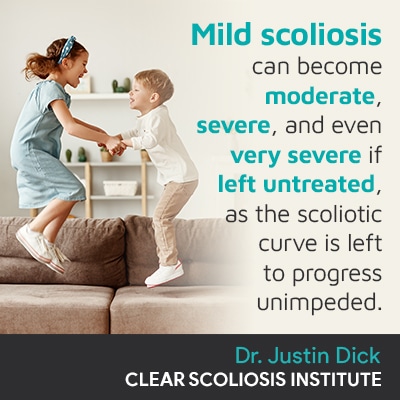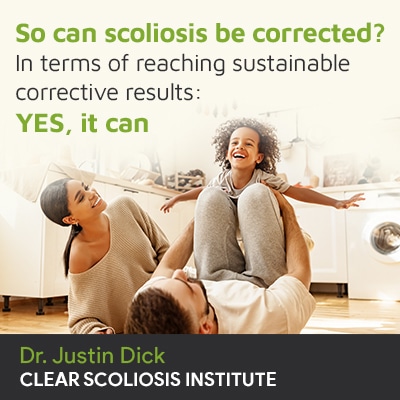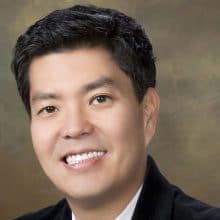![Can Scoliosis Be Fixed? Can It Be Corrected? [ANSWERED] Image](https://clear-institute.org/wp-content/uploads/2022/04/can-scoliosis-be-fixed.jpg)
While scoliosis can’t be cured in the traditional sense, it is highly treatable, and although early detection doesn’t guarantee positive treatment results, it does increase the likelihood of achieving curvature reductions. The focus of scoliosis treatment can also shift when treating older patients, versus younger ones.
As a progressive structural spinal condition, scoliosis isn’t curable, but it is highly treatable. While there are no guarantees, proactive treatment delivered through a conservative chiropractic-centered treatment approach can help patients achieve corrective results.
Before getting into the specifics of whether or not scoliosis can be fixed, let’s start with what it means to be diagnosed with scoliosis.
If a person is diagnosed with scoliosis, this means they have developed an unnatural sideways spinal curve, with rotation, and a minimum Cobb angle measurement of 10 degrees.
The fact that a scoliotic curve doesn’t just bend unnaturally to the side, but also twists from front to back, back to front, is the condition’s rotational component and makes it a 3-dimensional condition.
Cobb angle is known as the orthopedic gold standard in the assessment of scoliosis and is a measurement taken during X-ray that places a condition on its severity scale of mild, moderate, or severe.
Scoliosis is a structural condition, meaning it involves a structural abnormality within the spine itself, and this means that effective treatment has to, first and foremost, impact conditions on a structural level.
One of the most difficult aspects of a scoliosis diagnosis to explain is that as a progressive condition, it’s in its very nature to worsen over time, particularly if left untreated, or not treated proactively.
Related from the Podcast: What Scoliosis Means
This means that where a patient’s scoliosis is at the time of diagnosis is not indicative of where it will stay, and this also means that once diagnosed with scoliosis, it’s with that person for life.

So now that we know what a scoliosis diagnosis means in terms of what’s happening with the spine, and the condition’s progressive nature, let’s address a common condition-related question:
After giving a scoliosis diagnosis, one of the first questions I’m asked is can scoliosis be fixed?
This is one of the hardest questions to answer because in the traditional sense of meaning cured: no, scoliosis can’t be fixed.
What I counter this news with is that while we can’t cure scoliosis, we can most certainly manage its progressive nature, reduce curvatures on a structural level, and sustain those corrective results.
Another common question, of a similar nature, is whether or not scoliosis can be corrected.
While the terms corrected and fixed can seem interchangeable, in the context of scoliosis, a correction means something a little different.
When it comes to treating scoliosis, as a CLEAR-certified scoliosis chiropractor, I have key treatment goals that guide the process: achieving corrective results through a curvature reduction, increasing core strength so the spine is optimally supported, preventing further progression, and preserving the health and function of the spine.

Scoliosis is a complex condition to treat not just because it has such a wide range of severity, but also because there are different condition types and age groups affected.
Can Scoliosis be Corrected in Adolescents?
The most prevalent form of scoliosis is adolescent idiopathic scoliosis (AIS), diagnosed between the ages of 10 and 18, and this age group is at risk for rapid-phase progression.
While the idiopathic designation means we don’t fully understand why this type develops, what we do understand is what triggers its progression: growth and development.
As adolescents are entering into, or are in, the stage of puberty marked by unpredictable and rapid growth spurts, a big focus in treating scoliosis in adolescents is managing progression; this is achieved through significant curvature reductions, and working towards holding those reductions throughout adolescence, until skeletal maturity removes the big growth trigger.
So how do we achieve corrective results in adolescents: by being proactive and initiating treatment as close to the time of diagnosis as possible.
Remember, early detection doesn’t guarantee successful treatment, but it does increase the likelihood of achieving corrective results, as long as a diagnosis is responded to proactively.
When scoliosis is treated early in its progressive line, there are fewer limits to what we can achieve; this is because a smaller curve is more flexible and responsive to treatment.
In addition, the body has not yet had ample time to adjust to the unnatural spinal curve’s presence, meaning the muscles surrounding the spine are less likely to be strained and imbalanced due to trying to support a progressing unnatural curve over time.
In the treatment of adolescent idiopathic scoliosis, I combine multiple treatment disciplines so I can fully customize each and every treatment plan to address important patient/condition variables.
Through condition-specific chiropractic care, I can work towards adjusting the most-tilted vertebrae (bones of the spine) at the apex of the curve back into alignment with the rest of the spine; when successful, this impacts the condition on a structural level.
I also use a variety of therapies such as scoliosis-specific exercises (SSEs) that can help patients increase their core strength so the spine is optimally supported/stabilized, and there’s less pressure on the spine itself to maintain its curvatures and alignment.
When SSEs are integrated into a scoliosis treatment plan, they can also be effective in influencing posture and coordination by activating specific muscle groups and areas of the brain: impacting brain-body communication to help improve body-positioning.
Corrective bracing, such as the ScoliBrace, can also help with progression and augment treatment results by pushing the spine into a corrective position.
And what about adults? How do the treatment goals/process differ with adult patients?
Can Scoliosis be Corrected in Adults?
The answer to whether or not scoliosis can be corrected in adults is similar to the same question regarding adolescents: corrective results can be achieved in adult scoliosis, but can’t be fully corrected, as in cured.
While corrective results can be achieved in the treatment of adult scoliosis, the treatment focus does shift when compared to treating adolescents, particularly in terms of managing progression and pain.
As adolescents have not yet reached skeletal maturity, scoliosis is not a compressive condition; the lengthening motion of a growing spine counteracts the compressive force of a scoliotic curve.
As scoliosis introduces a lot of uneven forces to the body, this exposes the spine and its surrounding muscles and nerves to compression, which is known to be the main cause of condition-related pain.
In fact, while part of the reason early detection of AIS can be challenging is because it’s not typically painful, pain is the number one reason adults come to see me for a diagnosis and treatment.
So a shift in focus, when treating adults, involves pain management, which I proactively address by working towards increasing spinal stabilization and reducing curves, which impacts the underlying cause of pain: compression.
Another shift in treatment focus with adults can involve prep work to increase spinal flexibility prior to starting the regular course of treatment. As scoliotic curves progress, spinal rigidity becomes more of an issue and can limit the spine’s responsiveness to treatment.
As adults are also dealing with spinal degeneration, particularly over the age of 40, I want to include preventing further spinal deterioration and preserving as much function as possible in treatment.
Bracing for adults can help with pain management and stabilizing the spine, but is not as focused on large curvature reductions as in younger patients.
While scoliosis is still progressive in adults, once growth is no longer occurring, progressive rates tend to slow, meaning there is more time to focus on working towards corrective results; although, it should be clearly stated that even glacial progression, over time, can have the cumulative effect of a large curvature increase, so the time to start treatment is always now.
So while corrective results can most certainly be achieved in adults, and curvature reductions are always a goal, the treatment focus can shift from closely monitoring progression and large curvature reductions to smaller reductions, pain management, preserving function, and spinal stabilization.
It can be difficult for patients, and their families, to hear that scoliosis can’t be fixed or corrected in the traditional sense of being cured, but it’s important to understand that scoliosis is a highly-treatable condition.
Through proactive treatment, scoliosis progression and pain can be managed and curvatures can be reduced, but as an incurable condition, efforts will still have to be made, in the form of continued monitoring, chiropractic care, and home exercises, to sustain treatment results.
Although some adjustments and lifestyle changes might be necessary, a scoliosis diagnosis doesn’t have to define a person, nor limit their goals and opportunities; in fact, one of the best ways to help adolescents process a scoliosis diagnosis is to empower and motivate them through positive treatment results.
Here at the CLEAR Scoliosis Institute, our team of scoliosis chiropractors believe in the merits of proactive treatment that strives to preserve overall spinal health and function throughout treatment and beyond.

CLEAR provides a unique and innovative way of understanding scoliosis. Sign up to receive facts and information you won’t find anywhere else.
